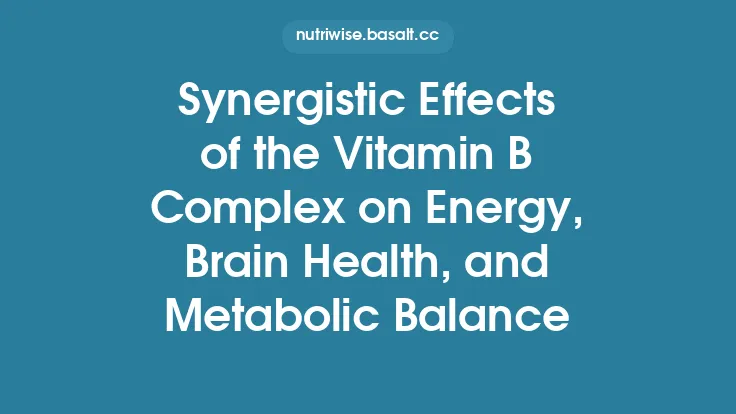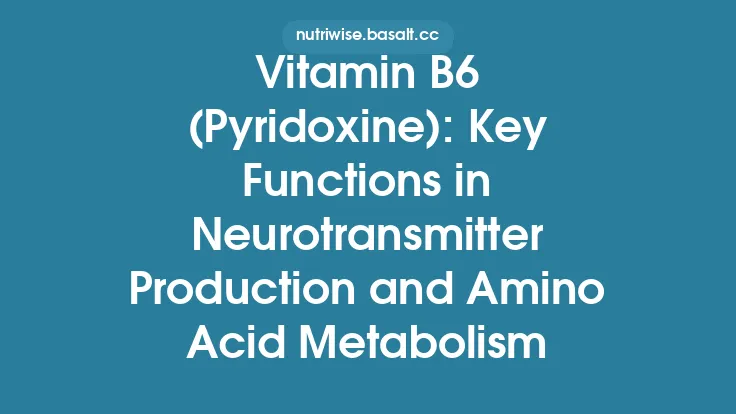Vitamin B12, also known as cobalamin, is a water‑soluble micronutrient that plays irreplaceable roles in the formation of healthy red blood cells and the preservation of a functional nervous system. Unlike many other nutrients, its biological activity hinges on a series of intricate biochemical transformations that occur after absorption, making its metabolism a fascinating example of molecular precision. Understanding how cobalamin operates at the cellular level provides insight into why its deficiency can lead to profound hematologic and neurologic disorders, and why adequate intake is essential across the lifespan.
Absorption and Metabolic Pathways
Cobalamin’s journey begins in the oral cavity, where salivary glands secrete haptocorrin (also called transcobalamin I). This binding protein protects the vitamin from the acidic environment of the stomach. In the duodenum, pancreatic proteases degrade the haptocorrin‑cobalamin complex, freeing the vitamin to bind intrinsic factor (IF), a glycoprotein produced by gastric parietal cells. The IF‑cobalamin complex then travels to the terminal ileum, where it is recognized by the cubilin‑amnionless receptor complex and internalized via receptor‑mediated endocytosis.
Once inside the enterocyte, cobalamin is released from IF and binds to transcobalamin II (TC II), forming the biologically active holo‑TC II. This complex circulates in the plasma and delivers cobalamin to peripheral tissues through receptor‑mediated uptake. Within cells, cobalamin is converted into two co‑enzyme forms:
- Methylcobalamin (MeCbl) – a co‑factor for methionine synthase, which catalyzes the remethylation of homocysteine to methionine.
- 5‑Deoxyadenosylcobalamin (AdoCbl) – a co‑factor for methylmalonyl‑CoA mutase, which converts methylmalonyl‑CoA to succinyl‑CoA in the mitochondrial matrix.
These conversions require adenosyltransferase and methyltransferase enzymes, and they are tightly regulated to ensure that each tissue receives the appropriate cobalamin form for its metabolic needs.
Role in Erythropoiesis
Red blood cell production is a multistep process that depends heavily on DNA synthesis. Cobalamin’s involvement is twofold:
- Methionine Synthase Activity – By facilitating the conversion of homocysteine to methionine, MeCbl supplies methyl groups for the regeneration of S‑adenosyl‑methionine (SAM). SAM serves as the universal methyl donor for the methylation of deoxyuridine monophosphate (dUMP) to deoxythymidine monophosphate (dTMP), a critical step in thymidine synthesis. Insufficient methylation stalls DNA replication, leading to ineffective erythropoiesis and the appearance of megaloblastic anemia.
- Methylmalonyl‑CoA Mutase Function – AdoCbl‑dependent conversion of methylmalonyl‑CoA to succinyl‑CoA integrates odd‑chain fatty acids and certain amino acids into the tricarboxylic acid (TCA) cycle. Accumulation of methylmalonic acid (MMA) in the absence of adequate cobalamin interferes with mitochondrial energy production in erythroid precursors, further compromising cell maturation.
The net effect of cobalamin deficiency is the production of large, immature red cells (macrocytes) with hypersegmented neutrophils, a hallmark of megaloblastic anemia. Because the bone marrow attempts to compensate by increasing erythropoietin output, patients may present with elevated reticulocyte counts that are nonetheless ineffective due to the underlying DNA synthesis block.
Mechanisms Supporting Nervous System Integrity
The nervous system relies on cobalamin for both structural and functional maintenance:
- Myelin Synthesis and Maintenance – Methylcobalamin is essential for the methylation of myelin basic protein and phospholipids that constitute the myelin sheath. Adequate SAM levels ensure proper methylation of phosphatidylethanolamine to phosphatidylcholine, a key component of myelin membranes. Deficient methylation leads to destabilized myelin, resulting in demyelination and the classic neurologic signs of peripheral neuropathy, gait disturbances, and proprioceptive loss.
- Neurotransmitter Regulation – SAM-dependent methylation also influences the synthesis and degradation of monoamine neurotransmitters (dopamine, serotonin, norepinephrine). While cobalamin is not a direct co‑factor for neurotransmitter enzymes, its role in maintaining SAM pools indirectly supports optimal neurotransmitter turnover, affecting mood, cognition, and autonomic function.
- Methylmalonyl‑CoA Mutase and Myelin Lipid Integrity – Accumulated MMA in cobalamin deficiency can be incorporated into abnormal fatty acids that disrupt the normal composition of myelin lipids. This aberrant lipid incorporation contributes to the structural breakdown of myelin and may trigger oxidative stress within oligodendrocytes.
- Homocysteine Regulation – Elevated homocysteine, a consequence of impaired methionine synthase activity, is neurotoxic. Homocysteine can act as an excitatory agonist at NMDA receptors, promoting calcium influx and neuronal apoptosis. By keeping homocysteine levels in check, cobalamin protects neurons from excitotoxic damage.
Collectively, these mechanisms explain why cobalamin deficiency can manifest as peripheral neuropathy, dorsal column dysfunction, optic neuropathy, and, in severe cases, subacute combined degeneration of the spinal cord.
Clinical Manifestations of Deficiency
The presentation of cobalamin deficiency is often a blend of hematologic and neurologic signs, which may appear independently or together:
- Hematologic – Fatigue, pallor, dyspnea on exertion, glossitis, and the laboratory hallmark of macrocytic, megaloblastic anemia with hypersegmented neutrophils. Serum lactate dehydrogenase (LDH) and indirect bilirubin may be elevated due to intramedullary hemolysis.
- Neurologic – Paresthesias, numbness, gait ataxia, loss of vibration and position sense, positive Romberg sign, and, in advanced cases, spastic paresis. Cognitive changes ranging from mild memory impairment to severe dementia have been documented, particularly in the elderly.
- Psychiatric – Mood disturbances, irritability, and, rarely, psychosis. These symptoms often improve with cobalamin repletion, underscoring the vitamin’s role in neurotransmitter homeostasis.
- Gastrointestinal – Glossitis, loss of appetite, and weight loss may precede hematologic abnormalities.
Because neurologic damage can become irreversible if treatment is delayed, early recognition based on clinical suspicion and targeted testing is critical.
Diagnostic Evaluation
A systematic approach to diagnosing cobalamin deficiency includes:
| Test | Interpretation |
|---|---|
| Serum Cobalamin | < 200 pg/mL (148 pmol/L) suggests deficiency; 200–300 pg/mL is borderline and warrants further testing. |
| Methylmalonic Acid (MMA) | Elevated MMA (> 0.4 µmol/L) is a sensitive marker of functional B12 deficiency, especially when serum B12 is borderline. |
| Homocysteine | Elevated homocysteine (> 15 µmol/L) indicates impaired methionine synthase activity; however, folate deficiency can also raise homocysteine. |
| Complete Blood Count (CBC) | Macrocytosis (MCV > 100 fL), hypersegmented neutrophils, and anemia. |
| Peripheral Blood Smear | Presence of macro-ovalocytes and hypersegmented neutrophils. |
| Neurologic Examination | Assessment of vibration sense, proprioception, gait, and reflexes. |
| Intrinsic Factor Antibody Test | Positive in pernicious anemia, the most common cause of malabsorption in adults. |
| Schilling Test (historical) | Rarely used today; replaced by antibody testing and MMA measurement. |
When serum cobalamin is low and MMA is elevated, the diagnosis is straightforward. In cases of normal serum cobalamin but elevated MMA/homocysteine, functional deficiency should be considered, especially in patients with malabsorption syndromes or on medications that interfere with cobalamin metabolism (e.g., metformin, proton pump inhibitors).
Dietary Sources and Bioavailability
Cobalamin is synthesized exclusively by microorganisms; therefore, dietary sources are limited to animal-derived foods where bacterial synthesis occurs:
- Meat and Poultry – Liver (the richest source), beef, lamb, and chicken.
- Fish and Shellfish – Salmon, trout, clams, and sardines.
- Dairy Products – Milk, cheese, yogurt.
- Eggs – Particularly the yolk.
The bioavailability of cobalamin from these foods varies. Liver provides up to 80 % absorption efficiency due to its high intrinsic factor‑binding capacity, whereas dairy and eggs have moderate absorption rates (≈ 50 %). Plant-based diets lack reliable natural sources of cobalamin, making fortified foods (e.g., breakfast cereals, plant milks) and supplements essential for vegans and some vegetarians.
Recommended Intake and Special Populations
The Recommended Dietary Allowance (RDA) for cobalamin varies by age, sex, and physiological status:
| Population | RDA (µg/day) |
|---|---|
| Infants 0–6 mo | 0.4 |
| Infants 7–12 mo | 0.5 |
| Children 1–3 yr | 0.9 |
| Children 4–8 yr | 1.2 |
| Children 9–13 yr | 1.8 |
| Adolescents 14–18 yr | 2.4 |
| Adults (≥ 19 yr) | 2.4 |
| Pregnant women | 2.6 |
| Lactating women | 2.8 |
High‑Risk Groups
- Elderly – Decreased gastric acid production impairs IF release, increasing malabsorption risk.
- Vegans/Vegetarians – Lack of animal foods necessitates fortified foods or supplements.
- Patients with Gastrointestinal Disorders – Crohn’s disease, celiac disease, or bariatric surgery can reduce ileal absorption.
- Individuals on Certain Medications – Long‑term metformin, proton pump inhibitors, and H2 blockers may lower serum B12.
- Pregnant and Lactating Women – Increased demand for fetal neurodevelopment and milk production.
Supplementation Strategies and Safety
When dietary intake is insufficient or malabsorption is present, supplementation becomes necessary. Forms of supplemental cobalamin include:
- Cyanocobalamin – A synthetic, stable form that is converted intracellularly to active MeCbl and AdoCbl. Widely used in oral tablets and intramuscular injections.
- Methylcobalamin – Directly bioactive for methylation pathways; often marketed for neurologic support.
- Hydroxocobalamin – Preferred for intramuscular therapy in pernicious anemia; has a longer plasma half‑life and can act as a nitric oxide scavenger.
- Sublingual Preparations – Offer an alternative route that may bypass some gastric limitations, though absorption data are mixed.
Dosage Recommendations
- Mild Deficiency – Oral cyanocobalamin 1 mg daily for 4–6 weeks, followed by a maintenance dose of 2–5 µg/day.
- Severe Deficiency or Malabsorption – Intramuscular hydroxocobalamin 1 mg weekly for 4–6 weeks, then monthly maintenance.
- Neurologic Symptoms – Higher or more frequent dosing (e.g., 1 mg daily) may be employed until neurologic improvement is observed.
Cobalamin has an excellent safety profile; excess is excreted in urine. Toxicity is rare, and no upper intake level (UL) has been established. However, very high parenteral doses can occasionally cause transient acneiform eruptions or, in predisposed individuals, hypersensitivity reactions.
Interactions and Considerations
- Folate Masking – High folic acid intake can correct the anemia of B12 deficiency without addressing neurologic damage, potentially delaying diagnosis.
- Medication Interference – Metformin (≥ 1 g/day) can reduce serum B12 by up to 30 % after 4 years of use; periodic monitoring is advised.
- Alcohol – Chronic consumption impairs IF production and may exacerbate deficiency.
- Genetic Variants – Mutations in the transcobalamin II gene (TCN2) or the methylmalonyl‑CoA mutase gene (MUT) can affect intracellular processing, necessitating individualized dosing.
Closing Perspective
Vitamin B12 stands out among the B‑complex vitamins for its indispensable contributions to both hematopoiesis and neural health. Its unique reliance on intrinsic factor for absorption, the dual co‑enzyme forms that drive DNA synthesis and fatty‑acid metabolism, and the downstream effects on myelin integrity and neurotransmitter balance illustrate a nutrient whose deficiency reverberates through multiple organ systems. By appreciating the biochemical underpinnings, recognizing at‑risk populations, and applying evidence‑based diagnostic and therapeutic strategies, clinicians and health‑conscious individuals can safeguard against the potentially irreversible consequences of cobalamin insufficiency. Maintaining adequate B12 status is therefore a cornerstone of lifelong vitality, supporting the oxygen‑carrying capacity of blood and the intricate wiring of the nervous system alike.





